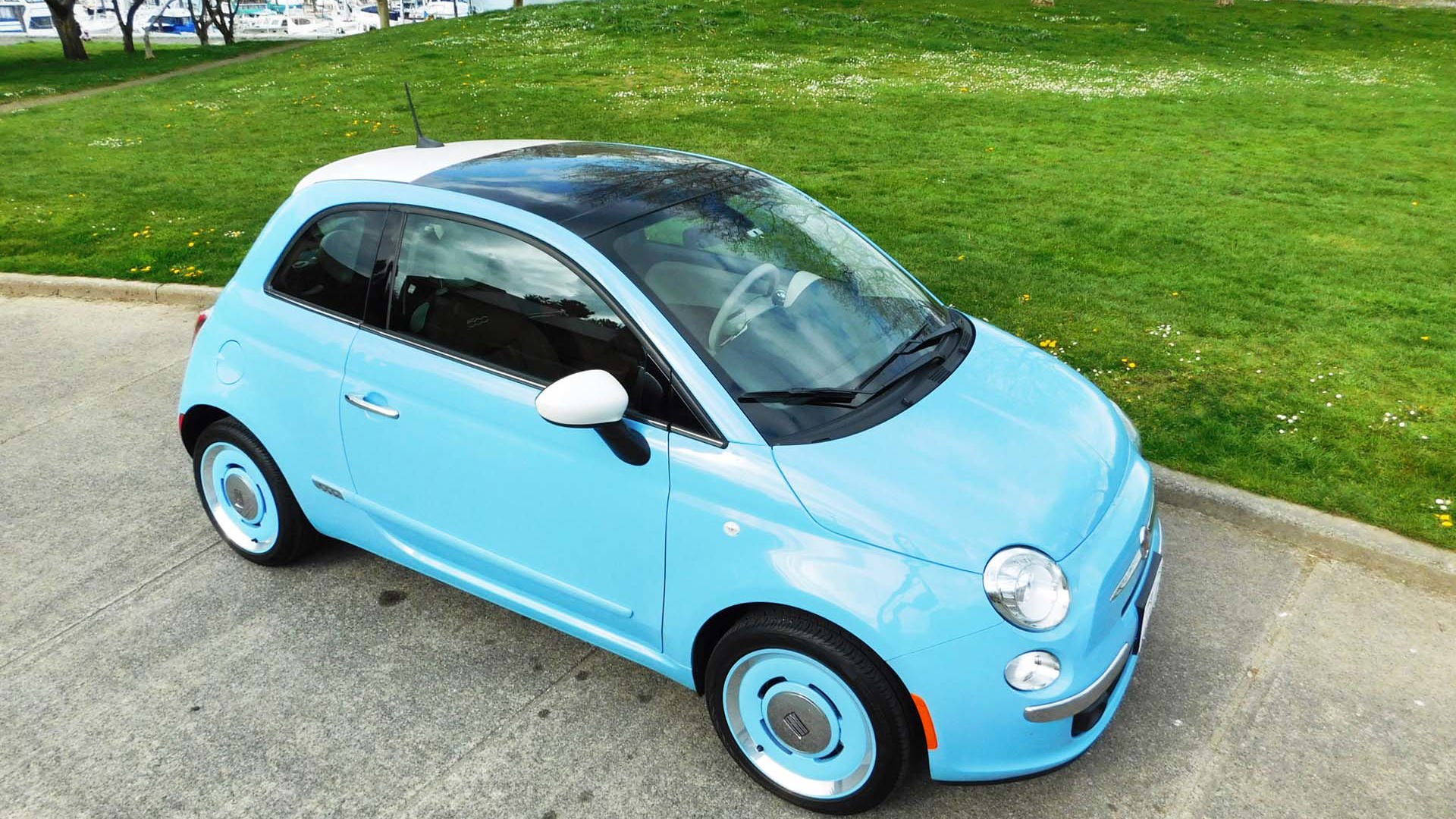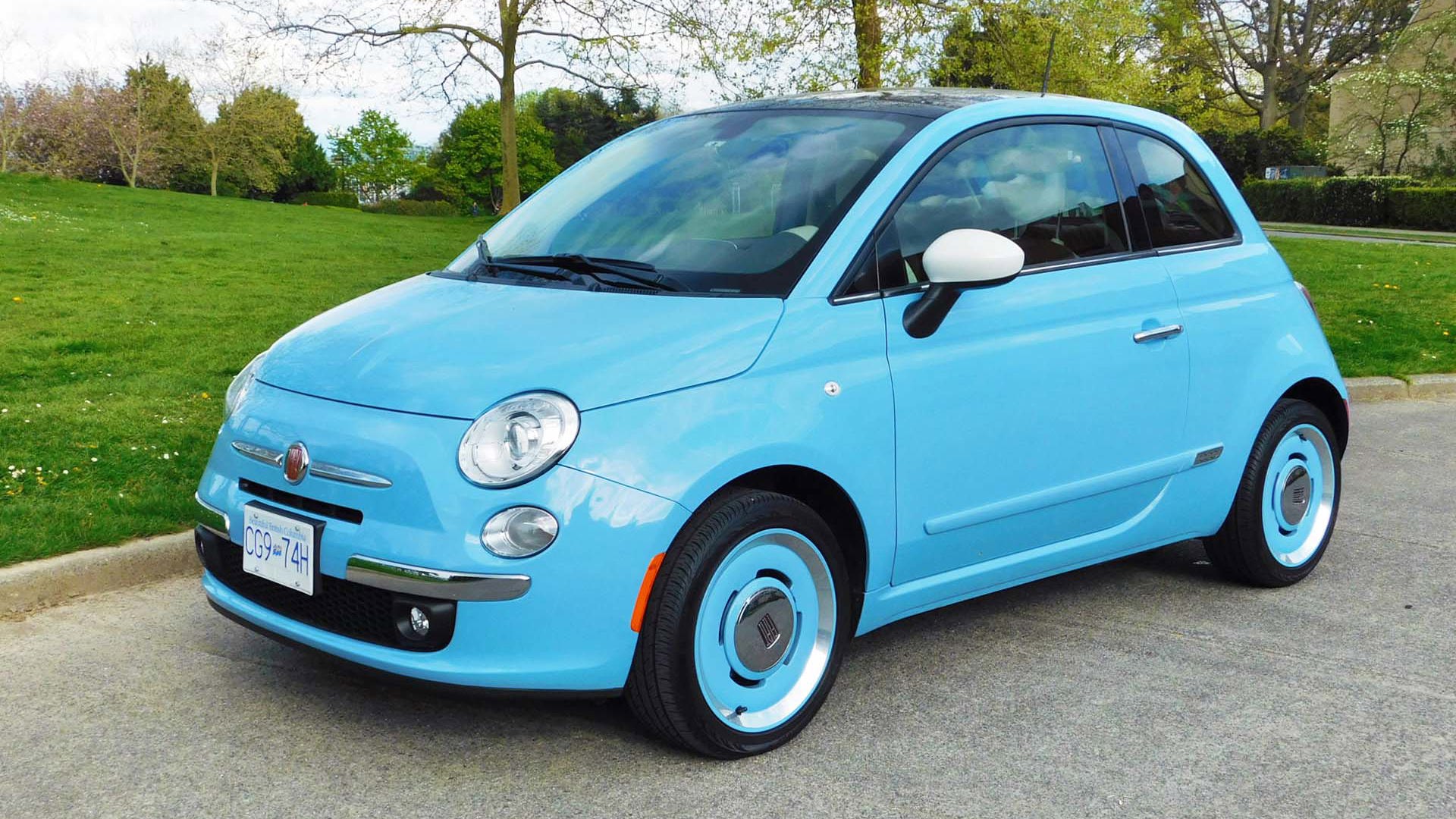 AutoTrader SCORE
AutoTrader SCORE
-
INTERIOR8/10
-
EXTERIOR STYLING8/10
-
FUEL ECONOMY9/10
-
PERFORMANCE6/10
-
COMFORT7/10
Fiat always has done things a little differently, and the North American–market 2016 Fiat 500 1957 Edition is a case in point. The original Fiat 500 was one of the world's first true "city cars", introduced in 1957 and continuing in production until 1975. Its stylish modern "Nuova 500" successor, which is based on the same platform as the Fiat Panda and Ford Ka, was introduced to the European market in 2007 and it finally made its way to North American shores for 2011. So far, so good.
If there's one thing better than a retro-styled car it's a retro-styled car with extra retro touches.
The Fiat 500 1957 Edition was introduced in 2014 to celebrate the 57th anniversary of the popular and diminutive original, and it stuck around for 2015 and now for 2016 because, apparently, if there's one thing better than a retro-styled car it's a retro-styled car with extra retro touches. It's available in only three colours, all suitably late-50s looking (a light olive green, a light blue, and a pale mint green).
Whether or not the 1957 Edition carries on into 2017 for the 500's 60th anniversary remains to be seen, though it would seem somehow fitting. In the meantime, Fiat has been busy in the design studio, and for 2016 the company introduced a refreshed 500 with a good-looking new front fascia and grille, expressive new headlight design, funky new LED taillights, and a refreshed interior design.
Now at this point you may be looking at the photos and thinking, "Wait a minute, this Fiat 500 looks exactly like last year's." And that's because my test car is a North American Fiat 500, and here in North America we don't get any of the exterior changes, just the refreshed interior. Sigh.
It's not clear why the exterior changes didn't make their way across the pond – fan forums suggest possibilities including difficulty obtaining U.S. approvals for the new lights, or excess stock of existing fascia panels at North America's Toluca, Mexico plant (European 500s are built separately in Tychy, Poland). Still, North American buyers can console themselves with the fact that:
- The European exterior changes, while indeed nice, are quite subtle, so only the most observant of neighbours would have known the difference anyway.
- The bigger news is the refreshed interior, and we do get that.
Where the previous interior was all pushbuttons and pixellated orange LCD displays, and featured an awkward optional TomTom navigation system that plugged into the top of the dash if you wanted to know where you were going, the new interior gets a revised central dash panel with a five-inch UConnect touchscreen display mounted in a slightly bulbous pod, flanked by the central dash vents and featuring proper volume and tuning knobs (hooray!). All models except the base Pop model also get a new seven-inch driver information display in the centre of the speedometer, with digital gauges that run around the perimeter (the Pop retains analogue gauges).
Voice-activated GPS navigation is available in all but the Pop trim, and while the five-inch touchscreen is a little small for navigational duties, it gets the job done and is certainly a huge improvement over the previous TomTom setup. Fiat-Chrysler's UConnect interface is decently intuitive, so connecting my phone and finding my way around the various infotainment functions proved easy and trouble-free.
The digital driver information display and gauges mean that sport mode, in addition to sharpening up the steering and throttle responses (and adjusting the transmission mapping in automatic-equipped cars) now also makes the digital speedometer switch to an italic font (italicized digits look faster because they're leaned over, right?) and replaces the guilt-inducing fuel consumption gauge with a gusto-rewarding throttle percentage gauge. Frankly, I've always found the 500's sport mode to be a little too subtle in the manual-equipped cars (the most noticeable change is the automatic-transmission mapping), so having the gauges do something different when you press the sport button is a nice bonus, even if a gauge telling you what your right foot is doing seems a bit unnecessary.
In terms of other features, the 1957 Edition is equipped pretty much as an upper-trim Lounge model (the regular lineup includes Pop, Sport and Lounge), with the real changes being cosmetic. So it gets the automatic climate control, leather upholstery, premium audio with satellite radio, panoramic sunroof, heated front seats, fog lights, auto-dimming rearview mirror, security alarm, cruise control, leather-wrapped steering wheel and such. The interior is fitted in a two-tone, brown-and-ivory colour scheme with rich-looking leather upholstery, and the steering wheel is a thing of true stylistic and tactile beauty, while everything else in the cabin is built from unremarkable rigid plastics.
Up front, the seats are quite upright but decently comfortable, with tilt (though not telescoping) steering allowing a moderate amount of adjustment. Rear seat passengers over about 5'3" will find the space somewhat cramped (at 5'11" I needed to move the front seat forward a little to sit behind myself, and I found my head brushing the roof), but at least there is a back seat, unlike in a Smart ForTwo. Cargo space is similarly tight at 185 L, but I found it was enough for a week's groceries for two people.
Outside, the 1957 Edition adds a white-painted roof, white exterior mirror caps, retro badging with the old elongated Fiat lettering, and unique retro-style body-coloured wheels in the same 195-45R16 size as the Sport (the 1957 Edition retains the standard suspension, however, so its ride is less firm than the Sport). The wheels, which feature big, chromed-centre caps and chromed "trim ring" rims, seemed to garner plenty of attention, and at traffic lights I'd catch people staring at them in fascination.
Under the hood, the 2016 Fiat 500 is the same as it ever was, with a naturally-aspirated 1.4L 16-valve Multiair engine that develops 101 hp and 98 lb-ft of torque and drives the front wheels via either a five-speed manual transmission or a six-speed automatic. What the engine lacks in terms of raw power and brute acceleration it makes up for with an effervescent, free-revving character. Especially with my test car's manual transmission, the Fiat 500 is genuinely entertaining to drive and makes you feel properly connected to the car, so while it might take nearly 10 seconds to accelerate from 0-100 km/h, you'll likely have a smile on your face by the time you get there thanks to the burbly engine note and the sheer enthusiasm with which the 500 seems to operate. (And if you really can't wait that long to reach 100 km/h there's always the Turbo or Abarth models, although you can't get them in the 1957 Edition trim.)
The 500 isn't a car that particularly encourages fast highway speeds due to its short wheelbase and resulting slightly nervous manner. However, it's a blast to tear around the city in – at least once you get used to the enormous blind spot created by the driver's side B-pillar – and it has surprisingly good handling for such a tall-looking car. You can feel it lean in the corners, certainly, and there's some choppiness over mid-corner bumps, but it sticks well to the tarmac and is oh-so-nimble and light on its feet. City fuel economy is good too, thanks to the 500's sub-1,100 kg curb weight (1,072 for the manually-equipped Pop trim). Official fuel economy ratings are 5.9 / 7.6 L/100 km (city/highway) and even my heavy-footed, almost-exclusively city driving returned an average of 8.8 L/100 km.
If the 500 has a weak spot it's perhaps in safety: it's a small car operating among larger vehicles, and while it scored mostly good results in IIHS crash tests it got a poor mark for small overlap front-end crashes. As a city appliance, however, the 500's small size comes with many benefits: it's nimble, fun to drive, easy to park, and reasonably efficient. When Fiat designed the 500, the company was targeting the Smart ForTwo, and the 500 easily eclipses that target thanks to its far more stylish appearance, better road manners and usable (albeit cramped) back seat.
Most buyers will likely cross-shop the 500 against the similarly retro-themed Mini Cooper and Volkswagen Beetle, or against other diminutive city cars like the Ford Fiesta, Honda Fit and Nissan Micra. In this crowd the Fiat is a mid-priced player. Starting at $18,995 before destination and topping out at $25,995 for the nicely-equipped 1957 Edition, it's a good bit costlier than its more practical-minded city-car competitors, but when similarly equipped it's less expensive than its two retro-themed rivals. For fashion-minded city folk, that might make it a perfect compromise, especially when kitted out with the 1957 Edition's nostalgically hip retro looks.
| Warranty: 3 years/60,000 km; 5 years/100,000 km powertrain; 3 years/unlimited distance corrosion perforation; 5 years/100,000 km roadside assistance Competitors: |
| Model Tested | 2016 Fiat 500 1957 Edition |
|---|---|
| Base Price | $25,995 |
| A/C Tax | $100 |
| Destination Fee | $1,795 |
| Price as Tested | $28,760 |
|
Optional Equipment
$870 (Rear park assist $375, GPS Navigation $495)
|
|










































